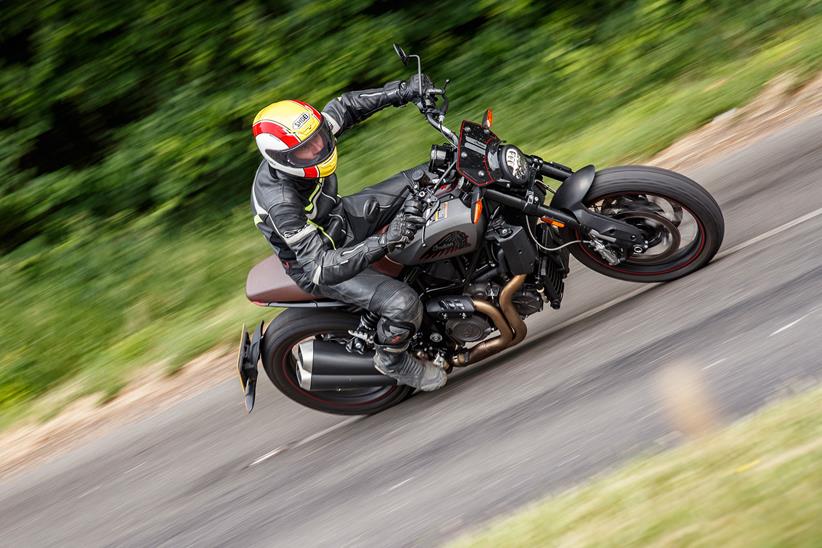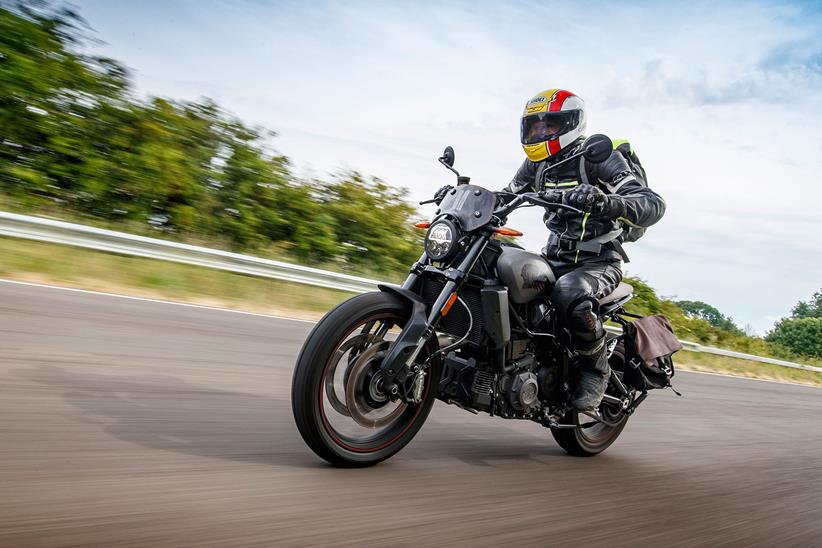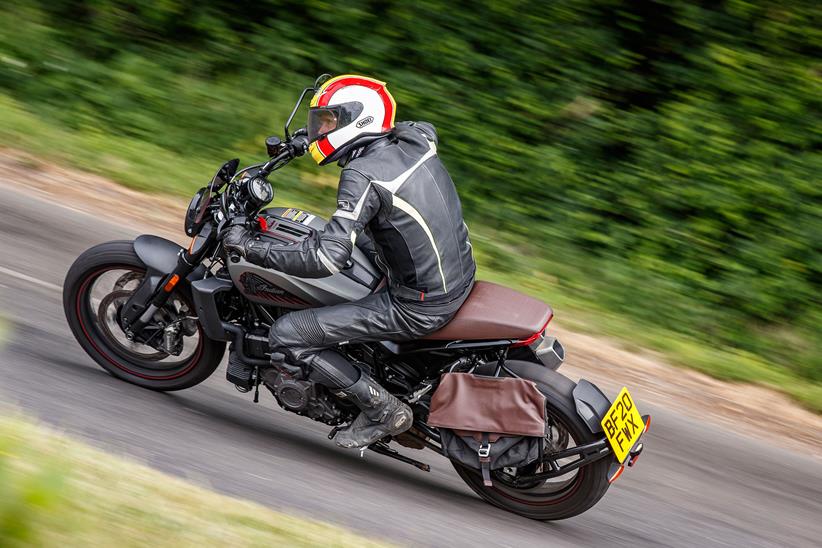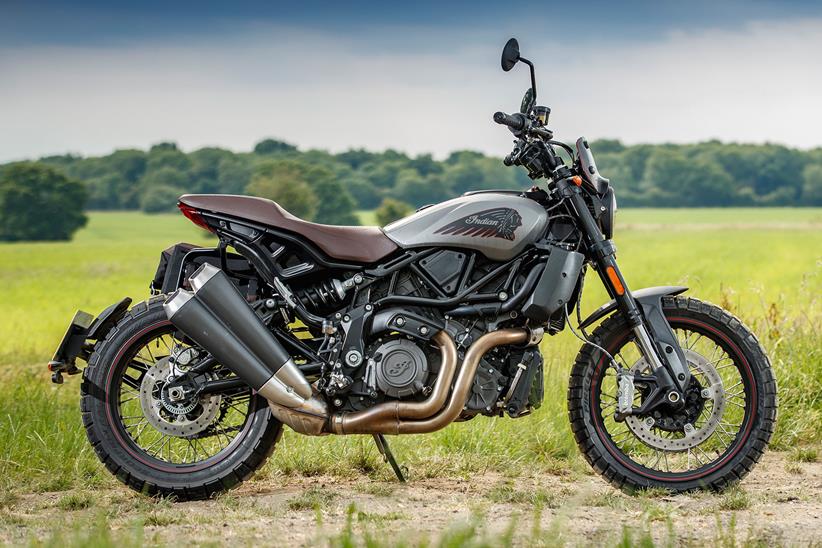Get ready to rally: Indian’s new FTR Rally ramps up the retro appeal
Last year’s Indian FTR1200 took me rather by surprise. Although obviously inspired by the firm’s dominant 750cc flat-track racers, I expected the road bike to be a laid-back retro rather than edgy and engaging. Steering, chassis feedback, riding position and build quality all impress, but it’s the 1203cc V-twin that’s the highlight.
- Related: 2021 Indian FTR review
It’s exactly how a large-capacity road-focused twin should be: tractable, free- revving, with instant torque throughout the rev range and punchy gearing making it both fast and friendly.
Related articles on MCN
- Indian FTR1200 S Race Replica bike review
- 131mph wheelie on Indian FTR1200 S
- Indian FTR1200 Carbon edition
For 2020 Indian have added this FTR Rally to the line-up. Costing £12,149, it’s scramblerised with spoked wheels, off-road tyres, altered riding position and the essential brown seat. Oh, and satin Titanium Smoke paint.
It sits between the standard FTR1200 on which it’s based (£11,899) and the FTR1200 S with its all-singing electronics, sportier suspension and touchscreen dash (£12,999). Indian also offer a Race Replica version of the S (£14,099) plus an FTR1200 Carbon (£14,699) with Akrapovic exhausts and, er… carbon.
![]()
All the pleasing bits about the FTR1200 are intact. The engine remains a fabulously flexible road unit, the chassis turns with ease, and there’s feel-good to the riding position and deportment. Tasty details too, like the cast footpegs and robust engine finish.
Ride quality is good, not great, though being evolved from the base model FTR means that Rally riders thankfully don’t have to endure the stiff and jiggly ride of the S.
The less-than-ideal elements of the FTR remain too. Pull away before the engine is fully warm and the fuelling is terribly lumpy – it’ll splutter, surge and stall at junctions. The Rally’s still fond of a drink too, returning just 38mpg.
![]()
This bike has refused to start a several times as well, needing jump leads to juice it up despite being brand new. I know of a dealer that supplies a trickle charger with every FTR sold, suggesting it’s not unique to this particular bike.
Unfortunately, the Rally also exaggerates an issue with all FTRs. The regular 1200 comes on Dunlop tyres designed to replicate the look of the DT3 rubber used on the FTR750 racer, and they’re not up to coping with 85 pound-feet of wallop and 230kg.
![]()
It’s all too easy to overwhelm the rear tyre (there’s no traction control on the stock 1200) and the Indian never feels entirely secure at big lean; changing the tyres on our long-term test bike last year transformed the grip and handling.
Things are worse on the Rally. The chunky Pirelli Scorpion Rally STR tyres might be trendy but they squirm when accelerating hard out of corners, move around mid- corner and – worst of all – spoil the FTR’s steering. It doesn’t help that the Rally’s spoke wheels have added several kilos to the wet weight, which is up into large adventure bike territory at 240kg.
The Rally uses the traditional- looking round display from the base FTR (nicked in turn from the Scout). There’s as much data as you realistically need, accessed from the oh-so-American switchgear, and the design better suits the style of the FTR than the touchscreen dash on the S model.
![]()
To allow ‘better control under rough conditions’ there are ProTaper ’bars with a two-inch greater rise. Given the Rally’s unchanged road suspension, size and weight it’s hard to imagine anyone tackling anything rougher than a gravel driveway, but they lend a more convincing scrambler feel.
This tweaked riding position is also completely upright. Control in town and at low speed is excellent but sustained motorway speed is harder work than on the standard FTR, even with the Rally’s flyscreen.
The ‘Aviator’ seat adds nothing apart from brownness. This bike also has the accessory messenger satchel thing (£174) and the required side rack (£128). Not really my bag (groan), but each to their own.
MCN verdict
![]()
The oversquare V-twin is fabulous, the chassis is fine quality, and it’s as well presented as everything else that Indian make. It’s just unfortunate that Indian’s route for expanding the FTR’s appeal affects it dynamically, as well as aesthetically. The knobblies and high bars give an on-trend retro-scrambler vibe, but also spoil the handling and make it harder to explore the potential of the engine.
Fair enough if you’re thudding around the city and fashion is a deciding factor – but I’d go for the base FTR1200 (and invest in good tyres).








